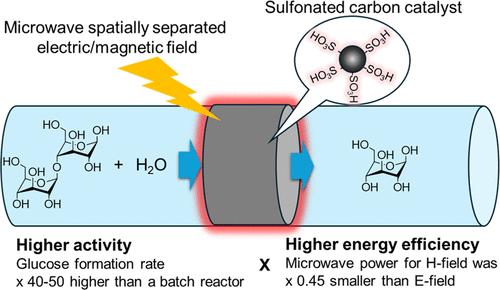空间分离微波电场和磁场流反应器中磺化碳催化剂上纤维素二糖的高效水解
IF 7.3
1区 化学
Q1 CHEMISTRY, MULTIDISCIPLINARY
引用次数: 0
摘要
增强多糖水解对于将多糖转化为食品、制药和生物基化学应用中使用的单糖和低聚糖是必不可少的。在本研究中,我们开发了一种高效的连续流水解工艺,利用微波和磺化碳催化剂(AC-SO3H),以纤维素二糖为模型糖底物。建立了带矩形波导和固态微波发生器的微波流动反应器,将微波作用于具有空间分离电场(E-)和磁场(H-)的固定催化剂床上,结果表明,在E-场下的微波流动反应可使葡萄糖的生成速率达到21.7 mmol/g / H,是间歇式微波反应器的35.3倍。由于AC-SO3H的介电损耗正切(tan δ)值(0.187)高于Amberlyst 70(0.040),其活性是Amberlyst 70的16-30倍。h场加热AC-SO3H也使葡萄糖生成速率提高了1.2 ~ 1.6倍。值得注意的是,h场将微波功率降低到e场的45%。因此,配备AC-SO3H催化剂的微波h场流反应器大大提高了纤维素二糖水解的产糖率和能量效率。本文章由计算机程序翻译,如有差异,请以英文原文为准。

Efficient Cellobiose Hydrolysis over a Sulfonated Carbon Catalyst in a Spatially Separated Microwave Electric- and Magnetic-Field Flow Reactor
Enhanced polysaccharide hydrolysis is essential for converting polysaccharides into mono- and oligosaccharide sugars for use in food, pharmaceutical, and biobased chemical applications. In this study, we developed an efficient continuous-flow hydrolysis process by applying microwaves and sulfonated carbon catalyst (AC-SO3H) using cellobiose as a model sugar substrate. We built a microwave flow reactor equipped with a rectangular waveguide and a solid-state microwave generator capable of applying microwaves to a fixed catalyst bed with spatially separated electric (E-) and magnetic (H-) fields and showed that the microwave flow reaction under the E-field improves the glucose formation rate up to 21.7 mmol/g per hour, which is 35.3 times higher than that achieved in the batch microwave reactor. AC-SO3H showed 16–30 times higher activity than Amberlyst 70 because of the higher dielectric loss tangent (tan δ) value of AC-SO3H (0.187) than Amberlyst 70 (0.040). H-field heating of AC-SO3H also improved the glucose formation rate by 1.2–1.6 times. Notably, the H-field reduced the microwave power to 45% of that of the E-field. Therefore, a microwave H-field flow reactor equipped with an AC-SO3H catalyst greatly improves both the glucose production rate and energy efficiency of cellobiose hydrolysis.
求助全文
通过发布文献求助,成功后即可免费获取论文全文。
去求助
来源期刊

ACS Sustainable Chemistry & Engineering
CHEMISTRY, MULTIDISCIPLINARY-ENGINEERING, CHEMICAL
CiteScore
13.80
自引率
4.80%
发文量
1470
审稿时长
1.7 months
期刊介绍:
ACS Sustainable Chemistry & Engineering is a prestigious weekly peer-reviewed scientific journal published by the American Chemical Society. Dedicated to advancing the principles of green chemistry and green engineering, it covers a wide array of research topics including green chemistry, green engineering, biomass, alternative energy, and life cycle assessment.
The journal welcomes submissions in various formats, including Letters, Articles, Features, and Perspectives (Reviews), that address the challenges of sustainability in the chemical enterprise and contribute to the advancement of sustainable practices. Join us in shaping the future of sustainable chemistry and engineering.
 求助内容:
求助内容: 应助结果提醒方式:
应助结果提醒方式:


